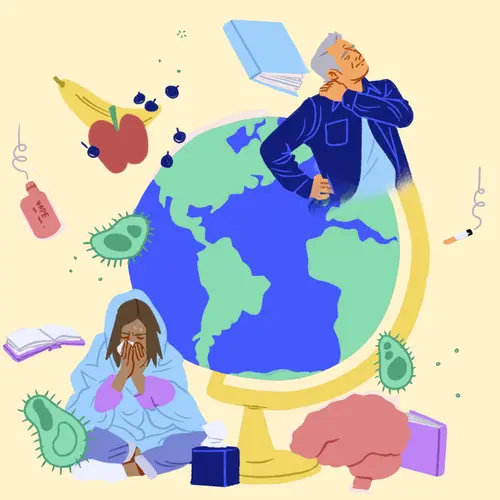Bipolar disorder, also known as manic depression, is an illness in which a person has periods of high mood and energy and other times of depression. People diagnosed with bipolar disorder usually have one or more major depressive episodes along with one or more manic or mixed episodes.
Bipolar mania is a prolonged state (at least one week at a time) of extreme elation or agitation accompanied by excessive energy. Symptoms of the manic "highs" include increased energy, racing thoughts and fast speech, excessive talkativeness, distractibility, reckless and aggressive behavior, grandiose thoughts, decreased need for sleep, feelings of invincibility, sexual inappropriateness including infidelity, excessive spending, and exaggerated self-confidence.
Bipolar depression is a prolonged state (at least 2 weeks at a time) of low energy levels and sadness or irritability. Symptoms of the bipolar depression may include a pessimistic attitude, social withdrawal, thoughts of death or suicide, extreme sadness, and irritability.
Manic or depressive symptoms also sometime co-occur as part of the same episode. For example, someone may have symptoms of both. When this happens, the episode is said to have ''mixed features.''
The term "rapid cycling" is used not to describe rapid shifts in mood from one moment to the next, but rather, a pattern that occurs when the patient has four or more distinct episodes of major depression, mania, and/or mixed features within one year. The length of time that the mood switches may range from days to months.
What causes bipolar disorder?
Though the exact cause of bipolar disorder has yet to be found, scientists confirm that bipolar disorder has a genetic component, meaning the disorder can run in families. Some research suggests that multiple factors may interact to produce abnormal function of brain circuits that results in bipolar disorder's symptoms of major depression and mania. Examples of environmental factors may include stress, alcohol or substance abuse, and lack of sleep.
Who is at risk of bipolar disorder?
More than 10 million Americans have bipolar disorder. Bipolar disorder affects men and women equally, as well as all races, ethnic groups, and socioeconomic classes.
Although men and women appear to be equally affected by bipolar disorder, rapid cycling is seen more often in women. Women also tend to experience more depressive and mixed-state episodes than do men. A man's first experience with bipolar disorder may be in a manic state; women tend to first experience a depressive state.
Bipolar disorder can present itself at any age, but typically, onset occurs around age 25.
Does bipolar disorder run in families?
Numerous studies have found that people with bipolar often have at least one close relative with depression or bipolar disorder.
Children who have one parent with the disorder have about a 10%-25% chance of developing the disorder themselves; children with two parents with the disorder have a 10%-50% chance. If a non-identical twin sibling has the disorder, the chance that another sibling will have it is about 10%-25%.
Studies of identical twins have shown that genetics are not the only factor in determining who is at risk for bipolar disorder. Because identical twins share all the same genes, if bipolar disorder were purely hereditary, then all identical twins would share the disorder.
However, it has been found that if one identical twin has bipolar disorder, the chances of the other twin also having bipolar disorder ranges from 40% to 70%. It is important to note that bipolar disorder can show itself in different forms in individuals in the same families.
Scientists believe that bipolar disorder is not likely caused by any one single gene but more likely by multiple genes, each contributing only a small amount to the vulnerability, acting together in combination with other environmental factors such as stress, lifestyle habits, and sleep. Scientists are working to identify these genes in the hopes that this will help doctors to better diagnose and treat the disorder.
Can lifestyle habits increase the risk of bipolar disorder?
Lack of sleep increases the risk of having an episode of mania in someone with bipolar disorder. In addition, antidepressants, particularly when taken as the only medication, may also trigger a switch into a manic state.
Excessive use of alcohol or drugs can also trigger bipolar symptoms. Research has shown that about 50% of bipolar sufferers have a substance abuse or alcohol problem. Sufferers often use alcohol or drugs in an effort to reduce unpleasant feelings during low mood periods or as part of the recklessness and impulsivity associated with manic highs.
Can environmental stress increase the risk of bipolar disorder?
People are sometimes diagnosed with bipolar following a stressful or traumatic event in their lives. These environmental triggers can include seasonal changes, holidays, and major life changes such as starting a new job, losing a job, going to college, family disagreements, marriage, or a death in the family. Stress, in and of itself, does not cause bipolar disorder (much the way pollen doesn't cause seasonal allergies), but in people with the biological vulnerability to bipolar disorder, having effective skills for managing life stresses can be critical to a healthy lifestyle in order to avoid things that can aggravate the illness (such as drugs and alcohol).

